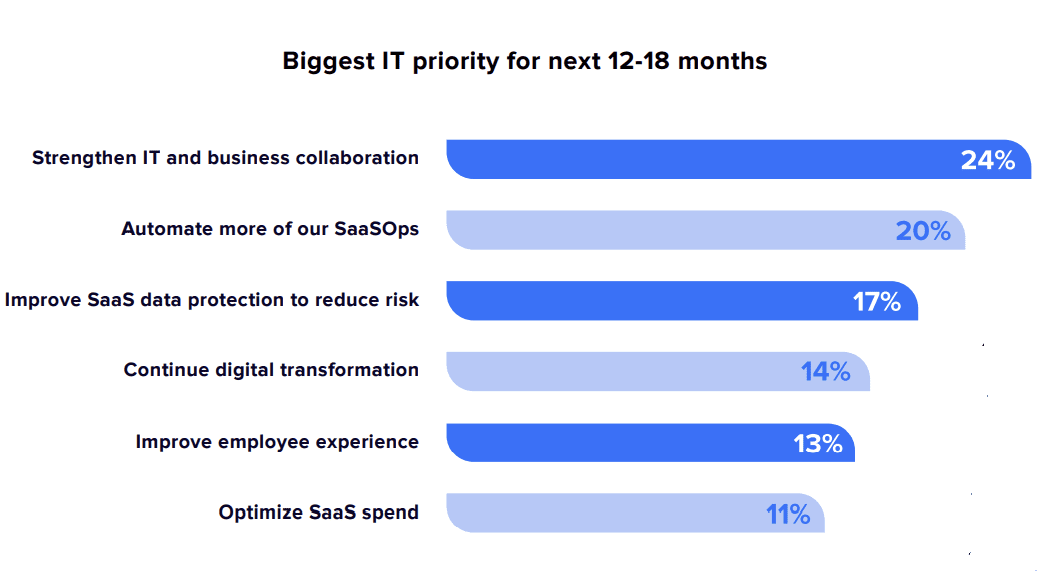Software-as-a-Service (SaaS) adoption has increased rapidly at the beginning of this decade. But recently, the yearly growth rate has slowed down a bit for the first time. Organizations are still adopting new SaaS applications, but at a slower rate than before. The annual growth rate was 38% last year, but this year it’s only 18%.
Medium-sized companies are more likely to add new SaaS applications than larger companies. As per a survey by BetterCloud, in 2022, most of the growth in SaaS apps came from these medium-sized businesses. Shadow IT may still cause problems like SaaS sprawl, unsanctioned apps, and limited visibility. 59% of IT professionals say that they find SaaS sprawl challenging to manage.
SaaSOps security and automation in 2022
SaaS security issues depend on how SaaS-forward an organization is. Nearly 20% of Traditional Workplaces had compliance-related penalties, legal fees, or fines in 2022. They were 9 times more likely than SaaS-Powered Workplaces to suffer the financial consequences of poor SaaS data security.
SaaS security is increasingly IT’s responsibility as 81% of respondents say that IT is responsible for protecting sensitive data within SaaS apps. To secure a constantly evolving SaaS environment, IT is now concerned about all aspects of SaaS security.
The convenience of SaaS can be risky. It’s never been easier for employees to save files in the cloud, but it’s also easy for them to share files in risky ways. This creates a big challenge for IT teams because they can’t see where sensitive data is or how it’s being used. There are also a lot of apps that people use without permission, and too many people have admin privileges. This is why security concerns persist.
Having complete visibility into a SaaS environment is important for security and also helps with operational efficiency. Automation can help companies be more efficient, but 64% of organizations say lack of visibility is a barrier to automation. Visibility and insights are essential for effective SaaSOps automation.
No matter how many SaaS apps they use, workplaces of all types agree that automation is important to managing SaaS environments. The majority of Traditional Workplaces know it, and 96% of SaaS-Powered Workplaces concur too.
In 2022, 72% of respondents are prioritizing IT automation and working toward it. More organizations are working to reap the benefits of IT automation. About one-third of their routine SaaSOps processes are already automated and they expect to nearly double this over the coming years.
By implementing automation, organizations were able to improve employee experience, and reduce the volume of help desk tickets and mean time to resolution (MTTR).
32% of IT professionals said they were able to improve operational efficiency by automating SaaS management. The top benefits of automating SaaS management in 2022 are shown below.

SaaSOps in 2023
SaaS will be the most common way that software is used in the future. Almost every organization will use it. Workplaces that are powered by SaaS will become even more reliant on cloud-based software in the coming years. While traditional workplaces are moving to the digital transformation more slowly, all types of workplaces are relying on SaaS to transform how people work.
In 2023, 24% of IT teams will be busy improving collaboration with other business departments to uplevel their impact, boost visibility, and drive innovation across the organization.
Other big priorities for 2023 are automating more SaaSOps tasks, improving SaaS data protection, and continuing the digital transformation journey.

83% of people think that in the next 12 months, employee experience will become more important to their business. They also think that IT will be responsible for employee experience in the next 12 months.
Zero-touch IT is more than just automating tasks. It’s about creating workflows that automate the entire process, from beginning to end. The goal is to reduce the number of manual “touchpoints” by IT support to as close to zero as possible. But achieving this goal requires overcoming some real barriers.
About 20% of people are of the opinion that too many legacy apps in their environment are making automation difficult. Lack of knowledge, skills, training, or time to learn on the job, and lack of budget are other factors hampering organizations.
80% of SaaS-Powered Workplaces, 75% of Workplaces in Transition, and even 57% of Traditional Workplaces agree that zero-touch is the future.
Source: BetterCloud
Read next: 52% of SMBs are not much confident in their cyber resilience, reveals study








